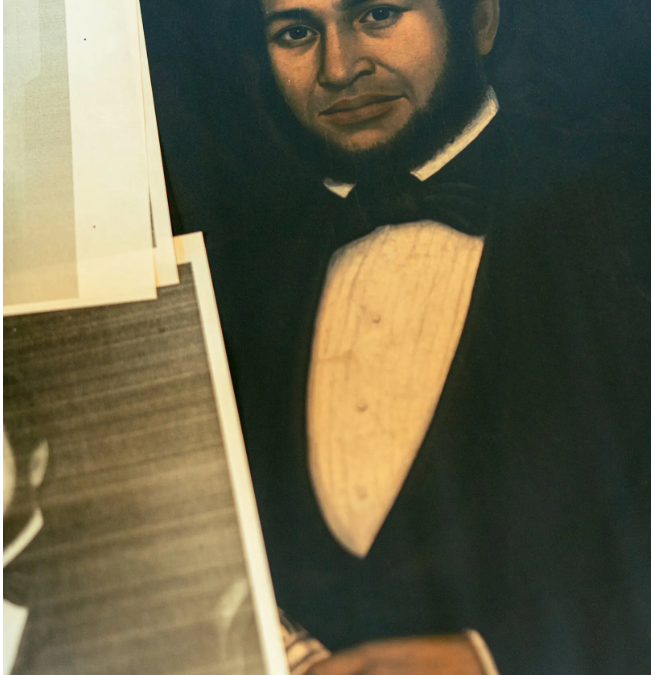One day in 1855, a man walked into a newspaper office in Sydney, Australia, with an odd request.
The man, later described as a “man of color” with “bright, intelligent eyes” and an American accent, was looking for a copy of the United States Constitution.
The text was procured, along with a recent book on the history of the United States. Two weeks later, the man returned with a nearly 20,000-word text of his own, bearing a blunt title: “The United States Governed by Six Hundred Thousand Despots.”
The first half offered an account of the author’s birth into slavery in North Carolina around 1815, his escape from his master, his years on a whaling ship and then his departure from “the land of the free” for the shores of Australia, where he went to work in the gold fields.
The second half was a long, blistering condemnation of the country he had left behind, in particular its revered founding document.
“That devil in sheepskin called the Constitution of the United States,” the man wrote, is “the great chain that binds the north and south together, a union to rob and plunder the sons of Africa, a union cemented with human blood, and blackened with the guilt of 68 years.”
The newspaper published the narrative anonymously, in two installments, attributing it only to “A Fugitive Slave.” How it was received is unknown.
The man’s words then sat, unread and forgotten, until a few years ago, when an American literary scholar came across them while digging around one night in an online newspaper database.

Now, it is being published for the first time in 169 years by the University of Chicago Press, under its unflinching original title, with the author’s name — John Swanson Jacobs — emblazoned on the cover.
The rediscovery of a long-forgotten slave narrative would be notable enough. But this one, scholars who have seen it say, is unique for its global perspective and its uncensored fury, from a man living far outside the trans-Atlantic network of white abolitionists who often limited what the formerly enslaved could write about their experiences.
And it comes with an uncanny twist: Jacobs was the brother of Harriet Jacobs, whose 1861 autobiography, “Incidents in the Life of a Slave Girl,” the first published slave narrative written by a formerly enslaved African American woman, is now seen as a cornerstone of the 19th-century literary canon.
Today, John Jacobs is remembered mostly as a footnote to his sister’s story. But Jonathan D.S. Schroeder, the scholar who rediscovered the narrative, said he hopes the book will restore Jacobs to history, placing him in the tradition of Black radicalism from David Walker’s incendiary “Appeal to the Colored Citizens of the World” from 1829 to the Black Lives Matter movement today.
The narrative is a “spectacular performance of autobiographical freedom,” Schroeder argues. And it raises a deeper question: How would other formerly enslaved people — including Jacobs’s more famous sister — have told their stories if they had been truly able to write freely?
A Homegrown American Genre
Slave narratives have been called the United States’ only homegrown literary genre, if also a complicated one. Well into the 20th century, they were dogged by questions about their authenticity, and the degree to which they had been shaped, or even fabricated, by white editors.
But today, the roughly 200 known to survive are prized both as direct testimony of enslavement and as the seedbed of a literary tradition that stretches from Frederick Douglass and Sojourner Truth to Toni Morrison and Colson Whitehead (whose novel “The Underground Railroad’ was partly inspired by Harriet Jacobs’s book).
Schroeder came upon John Jacobs’s 1855 narrative by an odd back door. Back in 2017, he was fresh out of graduate school in English, and trying to turn his Ph.D. dissertation about the history of nostalgia into a book.
Today, we may think of nostalgia, a term coined in the 1680s by a Swiss physician, as a pleasantly wistful state. But it originated as a medical diagnosis, which was often applied to despondent prisoners, soldiers and others seen as “irrationally” homesick, including enslaved people.
One night, after a day of working on a job application, Schroeder was digging around on the internet, trying to blow off “stress anxiety.” He had been reading the 2004 biography of Harriet Jacobs by Jean Fagan Yellin and was fascinated by the fact that both her brother and her son, Joseph, had gone to Australia — “physically pretty much the farthest away from America you could get,” as Schroeder put it.

Joseph died in Melbourne, apparently by suicide, around 1860. Had the cause of death been listed as “nostalgia,” Schroeder wondered? Looking for more information, he started plugging various spellings (and misspellings) of both men’s names into Trove, a database of digitized Australian newspapers.
Almost immediately, two articles popped up, published on subsequent days in April 1855, with the same striking title: “The United States Governed by Six Hundred Thousand Despots: A True Story of Slavery.”
“It felt like getting hit by a bolt of lightning,” Schroeder said. But he also didn’t want to get too excited. “I know how often these things turn out to not be what they appear to be.”
The narrative begins with the anonymous author’s birth in Edenton, N.C., where Harriet Jacobs was born. As he read the first installment, Schroeder noticed many other details that lined up with those in Harriet Jacobs’s as-yet unpublished book.
Then, two-thirds of the way through, there was a description of a letter the author had left for his enslaver in 1839, shortly before escaping from their hotel in New York City and fleeing by ship.
“Sir, I have left you not to return,” he wrote. The letter was signed, “No longer yours, John S. Jacob.”
The editors had left a letter off the surname. But this was clearly Jacobs.
“Then, I allowed myself to be hit with the full force of it,” Schroeder said.

The next day, Schroeder contacted Caleb Smith, an English professor at Yale, to ask for advice. Smith, who in 2013 drew headlines for authenticating the earliest known memoir by an imprisoned Black American, from the 1850s, called Jacobs’s narrative an “exciting” find.
“We are accustomed to thinking about slavery in terms of silenced voices, lost stories, lives that left only cryptic traces in the archives,” Smith said in an email. “But the voice here is loud and clear in its rage.”
Manisha Sinha, a leading historian of abolition at the University of Connecticut, called it “a major discovery” and “a wow,” which adds to our understanding of the evolution of Black antislavery activism.
Historians have known John Jacobs as a barely documented player in radical abolitionist circles of the 1840s, who sometimes lectured alongside Frederick Douglass, his neighbor in Rochester, N.Y.
In 1851, Douglass broke with the white abolitionist William Lloyd Garrison, rejecting his view of the Constitution as an irredeemable “covenant with death.” But unlike Douglass, Sinha said, “Jacobs doesn’t give up on his radical indictment of the United States.”
Scattered in the Archives
Schroeder, now 43 and teaching at the Rhode Island School of Design, was initially uncertain what to do with the discovery. A literary agent recommended he research a full biography to publish alongside the text. So Schroeder transformed himself from an interpretive literary scholar into an old-fashioned archive hound.

Today, many scholars of slavery emphasize the silences and biases of the archive. “It’s important to know that the records you are looking at weren’t set up to preserve the life of the person you are writing about, and often quite the opposite,” Schroeder said.
Most scholars had assumed that Yellin, who spent three decades researching Harriet Jacobs, had tracked down most of what could be found about the Jacobs family. (Yellin died in 2023.) But Schroeder found many previously unnoticed records, including a forgotten oil portrait from 1848 that he believes depicts John.
In Boston, he uncovered court documents describing Jacobs’s great-grandparents’ attempt to escape slavery in the 1790s. In London, he found ship logs that allowed him to trace Jacobs’s wanderings after he left Australia for London in 1856.
From his base in London, Jacobs spent the next 15 years working on ships carrying sugar from the Caribbean, oranges from the Black Sea, cotton from Egypt. He also helped finish the trans-Atlantic telegraph line and, in 1869, sailed to Bangkok on a gunboat delivered as a present for the new king of Siam.
Jacobs, Schroeder writes, “lived a life that was even more incredible than his narrative.” But his traces, he said, were “scattered to the wind.”

In 1860, as Harriet’s book was about to appear, John decided to republish his own narrative. Before a voyage to Brazil, he entrusted the text to a London magazine called Leisure Hour.
The editors chopped it nearly in half, excising most of its political arguments and turning it into a more conventional tale of suffering and escape. And gone was the original title, with its blast at the 600,000 American “despots” who owned fellow human beings.
“They cut out the radical contract that Jacobs asks the reader to submit to,” Schroeder said, “which is to pay attention not to enslaved people in pain, but to the people and laws that create the pain.”
Brother and Sister
John Jacobs died in 1873, a few months after returning to the United States. Today, few of the literary pilgrims who go to Mount Auburn Cemetery in Cambridge, Mass., to visit Harriet’s grave are likely to pause over the small marker set into the grass nearby, labeled simply “Brother.”
But Schroeder hopes his research will prompt a rethinking of the siblings’ interconnected stories.
Harriet’s book, which includes harrowing descriptions of sexual abuse, borrowed conventions from the sentimental novel, to better appeal to the target audience of antislavery Northern white women. John’s narrative, Schroeder writes, is “unsentimental to its core.” But were their stories originally intended to be so different?
Both siblings, Schroeder writes, began thinking about their books in the period when they lived together in Rochester, in the late 1840s, and possibly “intended for their stories to be read together.” And in the late 1850s, Schroeder writes, John seemed to encourage Harriet, who visited London, to publish her book there.

In her biography, Yellin describes how Harriet spent three years trying to get her book published, which meant getting the imprimatur of white benefactors. Twice, she asked Harriet Beecher Stowe for an endorsement, and was rebuffed. When “Incidents in the Life of a Slave Girl” was finally published in 1861, in Boston, the white editor revised it heavily, and cut a closing tribute to the radical abolitionist John Brown.
At the end of her book, Harriet describes John’s departure for California. What would her finished book have been like, Schroeder wonders, if she had joined him — and then, like him, continued even farther?
“There were invisible constraints on formerly enslaved authors who remained in the United States,” Schroeder said. Without the two versions of John Jacobs’s narrative, “we wouldn’t see that as clearly.”
–nytimes.com



